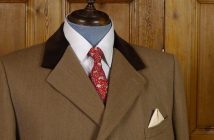Loulou de la Falaise, the bohemian, renaissance-loving designer and former muse to Yves Saint Laurent, synonymous with the designer’s 70s era entourage of creatives and beautiful people, died on November 5th, aged 63.
A rich and divine mix of chic français and Irish/English roots, Falaise was born in England to Maxime Birley (an occasional model for Elsa Schiaparelli) and Alain de la Falaise, a writer, translator and French count. The iconic relationship between de la Falaise and Yves Saint Laurent began in the late 1960s when, after being hired as a model for Vogue by pioneering editor-in-chief Diane Vreeland and a stint as junior fashion editor at Queen magazine, she joined his fashion house designing knitwear and the chunky bracelets and necklaces that helped define the YSL look, later serving as the muse for his iconic Le Smoking Tuxedo, debuted in the summer of 1966 as part of his A/W 66/67 Haute Couture collection. It remains one of the most enduring and powerful fashion creations of the last century and, in the 21st century, continues to inspire designers such as Tom Ford and Alber Elbaz. Actor James Franco even channelled de la Falaise and Le Smoking, on the cover of Candy magazine this year, shot by photographer Terry Richardson.
A controversial alternative to the LBD or an evening gown, Le Smoking was a favourite among the chic collective of late 60s/early 70s style icons including Catherine Deneuve, Francoise Hardy, Liza Minelli, Lauren Bacall and Bianca Jagger. For de la Falaise, the association propelled her into the limelight and she formed an instant bond with another of YSL’s muses, Betty Catroux, an androgynous beauty to whom the designer referred as his “twin sister”. The two women appeared with YSL in the now-famous photograph outside the opening of his first London boutique in 1969, de la Falaise wearing a coat dress and silk headscarf. She said of her friendship with Catroux, “The truth is that what Yves found attractive in me was the fantasy, over-the-top bedecked look. Betty Catroux was the one who inspired all of his mannish looks; I’ve always been the gypsy influence.”
After Saint Laurent announced his retirement from fashion design in 2002, de la Falaise began collaborating with Oscar de la Renta, but more significantly, she launched her own signature ready-to-wear line, selling her designs in two stores in Paris and also in Bergdorf Goodman. The collection was a fusion of her own eclectic personal style: impeccably cut blazers in English tweeds matched with linen sailor pants, and pretty, colourful knits twinned with striped silk blouses under masculine walking coats. She once said of her clashing tastes, “To have style, you have to strike a note of surprise: bring together unlikely elements, such as a country sweater with a diamond necklace or a tennis-striped pantsuit with a delicate pale-pink brooch.”
She eventually reduced her businesses to one boutique, on the Rue Cambon in Paris, and she also began selling her jewellery designs via the Home Shopping Network in the US and smaller boutiques in London. The range included her signature wolf symbol, seen on a belt clasp, drop earrings or biting on a gemstone such as a pearl or diamond set atop a ring. The wolf was chosen as her statement icon because it was “untamable and faithful to his pack”, and also because in French wolf is ‘loup’, pronounced ‘lou’, so de la Falaise also embodied the symbol that adorned her designs: the ‘wolf in women’s clothing’.
De la Falaise was not just a muse to YSL of course; she was also admired for her Marlene-Dietrich-like features by photographers including Richard Avedon, Irving Penn and Helmut Newton, whom she posed for in the 70s in a series of black and white portraits in front of a mirror, seen in the volume White Women. She was also one of the protagonists of glittering Studio 54 night life, often seen with other visionaries of the time, including Robert Mapplethorpe, Paloma Picasso and Halston, another designer who, like YSL, defined an era of fashion.
De la Falaise leaves a footprint that will remain forever, which is just as well, because she told Vogue Italia in 2010 her motto was to always “keep moving”.
Loulou de la Falaise, 4 May 1948-5 November 2011.




